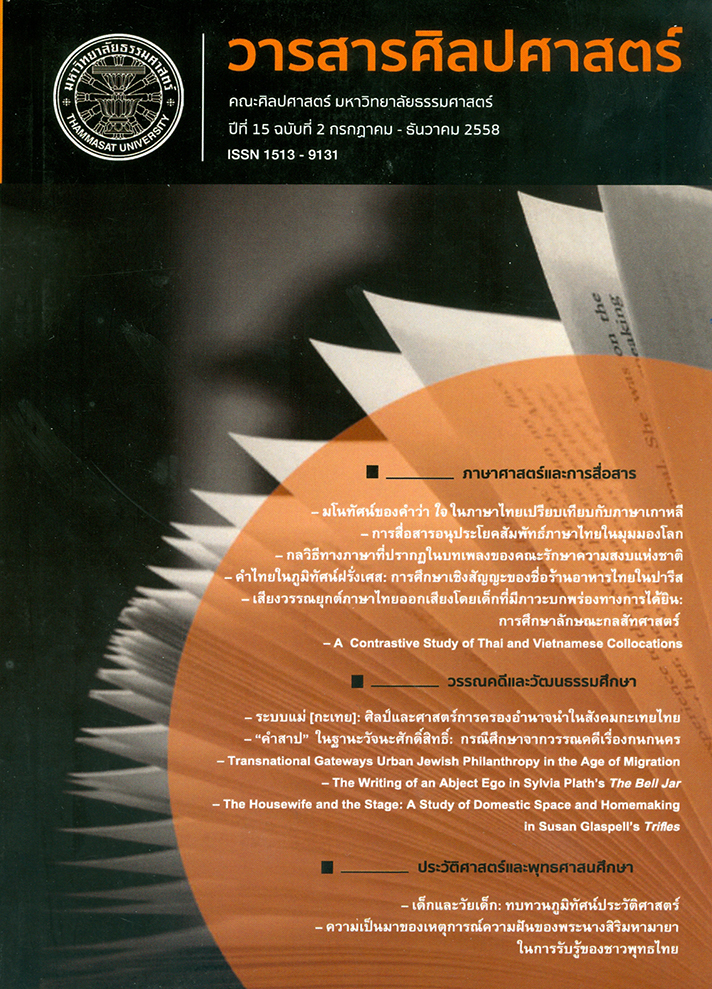การสื่อสารอนุประโยคสัมพัทธ์ภาษาไทยในมุมมองโลก
Main Article Content
บทคัดย่อ
ในแวดวงการศึกษาไวยากรณ์ไทยที่ผ่านมานั้น ส่วนใหญ่ศึกษาอนุประโยคสัมพัทธ์ในมุมมองด้านโครงสร้างโดยมองคล้ายกันว่าอนุประโยคสัมพัทธ์หมายถึงประโยคที่ใช้ขยายคำนามซึ่งมีคำเชื่อมคือ ที่ ซึ่ง อัน ซึ่งใช้แตกต่างกันไปตามปริบทแต่ในมุมมองจากไวยากรณ์หน้าที่นิยมแบบลักษณ์ภาษานั้นมีภาพที่แตกต่างออกไป คือมองภาษาไทย ในฐานะที่เป็นการสื่อสารภาษาหนึ่งของโลกการศึกษาไวยากรณ์ภาษาไทย เพื่อการกำหนดหรือแบ่งหมวดหมู่ไวยากรณ์ต่างๆ จึงต้องเทียบเคียงได้กับภาษาอื่นๆ ในการที่จะจัดเข้ากลุ่มต่างๆ ในภาษาโลก ในการศึกษาไวยากรณ์จะต้องพิจารณาหน้าที่ในการสื่อสารในปริบทเป็นสำคัญมากกว่าที่จะพิจารณารูปแบบหรือโครงสร้างแต่เพียงประการเดียว ในแนวคิดนี้ อนุประโยคสัมพัทธ์เป็นการสื่อสารเหตุการณ์ที่มีส่วนประกอบหนึ่งอ้างถึงร่วมกันกับคำนามหลัก และมีบทบาทในเชิงวัจนปฏิบัติศาสตร์ที่เป็นสภาวะเกิดก่อน ซึ่งเป็นที่รู้จักหรือคุ้นเคยต่อผู้ฟังมาก่อน จึงสามารถเข้าไปกระตุ้นถึงความทรงจำส่วนใดส่วนหนึ่งของผู้ฟังได้ในขณะนั้น อนุประโยคสัมพัทธ์ในภาษาไทยมีหลายรูปแบบ ขึ้นอยู่กับกลวิธีการค้นคืนการก ซึ่งมีหลายกลวิธี ได้แก่ กลวิธีแบบไม่ฝัง กลวิธีแบบช่องว่าง กลวิธีแบบสรรพนามอ้างตาม กลวิธีแบบสรรพนามสัมพัทธ์ กลวิธีแบบการแปลงเป็นนาม กลวิธีแบบการคงการก และกลวิธีแบบประสมประสาน
คำสำคัญ อนุประโยคสัมพัทธ์ ไวยากรณ์หน้าที่นิยมแบบลักษณ์ภาษา หน้าที่ในการสื่อสาร
Regarding previous studies in the Thai grammar, most of the studies in relative clauses have been conducted in the view of Structuralism. That is, they have viewed relative clauses as nominal modifying clauses that are linked to the head nouns with the relative pronouns tʰî:,sɨ̂ŋ and?an, which are differently used in particular contexts. In the view of Functional-typology Grammar, however, such grammatical category is differently treated. That is, this framework views Thai, among others, as a communicative language of the world. Any grammatical categorization in Thai, then, is supposed to be comparable to other languages in the world language classification. In doing this, the grammatical study must take the communicative function in contexts as a principle part, rather than the sole form or structure. In this view, a relative clause is a communicative event where one argument is co-referential with the head noun and has a pragmatic function as a presupposition that is familiar to the listener so that it can currently stimulate a part of the listener’s memory. Relative clauses in Thai are recognized in various characteristics depending on case-recoverability strategies such as non-embedded, gap, anaphoric-pronoun, relative-pronoun, nominalization, stranded case-marking and mixed strategies.
Keywords: Relative clauses, Functional-typology Grammar, Communicative function


